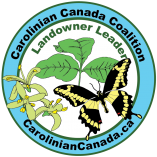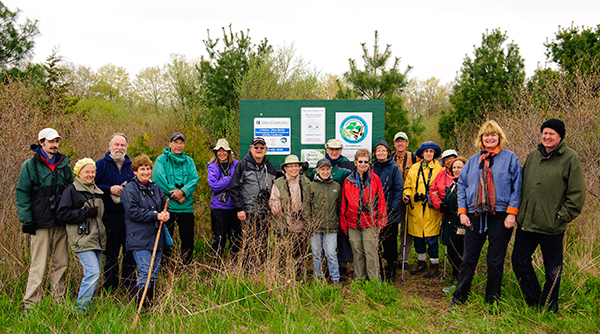
Landowner Leaders Profile
|
Carolinian Canada Landowner Leaders Stan and Anita Caveney host a Nature London field trip. photo: Chad Day |
"I have attached the beautiful CCC LL/CHAP sign onto a natty signboard, together with other plaques recognizing help with conservation projects at MeadowWoods over the years. The signboard faces South along Gray Line. The Carolinian Canada sign is definitely the highlight of the display!" -Stan Caveney |

In 2004 Stan and Anita Caveney, purchased a tract of land in Elgin County for conservation purposes and personal enjoyment in their retirement. The 105-acre undeveloped property, which they named MeadowWoods, lies along Gray Line in the southwestern corner of the Municipality of West Elgin. It contains patches of Carolinian woodland flanking the steep Sherman Creek valley and wet tableland meadows. The property was retired from farming in 1991, but for nearly 150 years previously its upland areas had been cropped and its wooded valley slopes used to pasture dairy cattle. Apart from a scattering of White Pine planted in the meadow areas by the previous owner, regeneration on the property had been allowed to progress naturally.
The property lies in the Southwest Elgin Forest Important Bird Area, an important pathway for migratory raptors along the Lake Erie shoreline and a breeding area for rare songbirds in Canada. The site is recognized in Carolinian Canada’s Big Picture 2000 as part of a wildlife corridor connecting Rondeau Provincial Park and the Skunk’s Misery Natural Area.
In 2006 the inherently wet nature of the upland meadows was enhanced when two small wildlife wetlands were installed with funding provided by the Habitat for Healthy Waters Program, a partnership between Ontario Stewardship, Ducks Unlimited Canada and the Ontario Trillium Foundation. In 2008 a larger 2-acre wetland (including 0.7-acre area of open water) was installed by the Elgin Stewardship Council with support from Environment Canada’s EcoAction Program and the HIVA Foundation.
In 2007 the approximately 70 acres of woodland on the property was registered with Ontario’s Managed Forest Tax Incentive Plan. The different wooded habitats will be managed for environmental conservation in order to protect and enhance the natural features on the property and improve the quality of wildlife habitat. Approximately 1,000 deciduous trees native to the area have been planted with the assistance of the ESC, Lower Thames Valley Conservation Authority and members of the 2nd London Scout Group.
The Caveney’s goal is to restore a continuous strip of riverine forest through the property and to increase forest interior habitat. Many of these seedlings have been caged to protect them from the abundant populations of local White-tailed Deer and Cottontail Rabbit. In addition, the non-wooded forest edge, successional wet meadow, meadow thicket and open grassland habitats on the property will, where possible, be managed to conserve the breeding habitats required by many threatened bird species.
There are several records of rare species and species at risk on the property. The Caveney’s have identified 39 species of dragonflies and damselflies on their property, including the rare Comet Darner, which has only been recorded in Ontario once or twice before.
Dr. Jim Bogart of the University of Guelph conducted a genetic analysis on a dead salamander Stan found on the property and determined it to be a hybrid between a Blue-spotted Salamander and Jefferson Salamander, indicating that it is almost certain that pure Jefferson Salamanders, an endangered species, exist on the property. The Caveneys have also observed Snapping Turtles in their ponds, which were uplisted to “species of special concern” in Ontario in 2009.
The mature block of Carolinian forest on the property contains mature and healthy specimens of two species-at-risk trees, Butternut and Eastern Flowering Dogwood. Perhaps the most exciting discovery for Stan has been the presence of the Yellow-breasted Chat, a warbler listed as a species “of special concern” under Ontario’s SARO and “endangered” federally. Stan first heard its song in 2009 and the following summer, with the help of Mike Cadman and Christine Bishop of Environment Canada, a nest containing 3 eggs was discovered in a small dogwood bush, deep in a thicket of willow, brambles, wild grape, and autumn olive.

